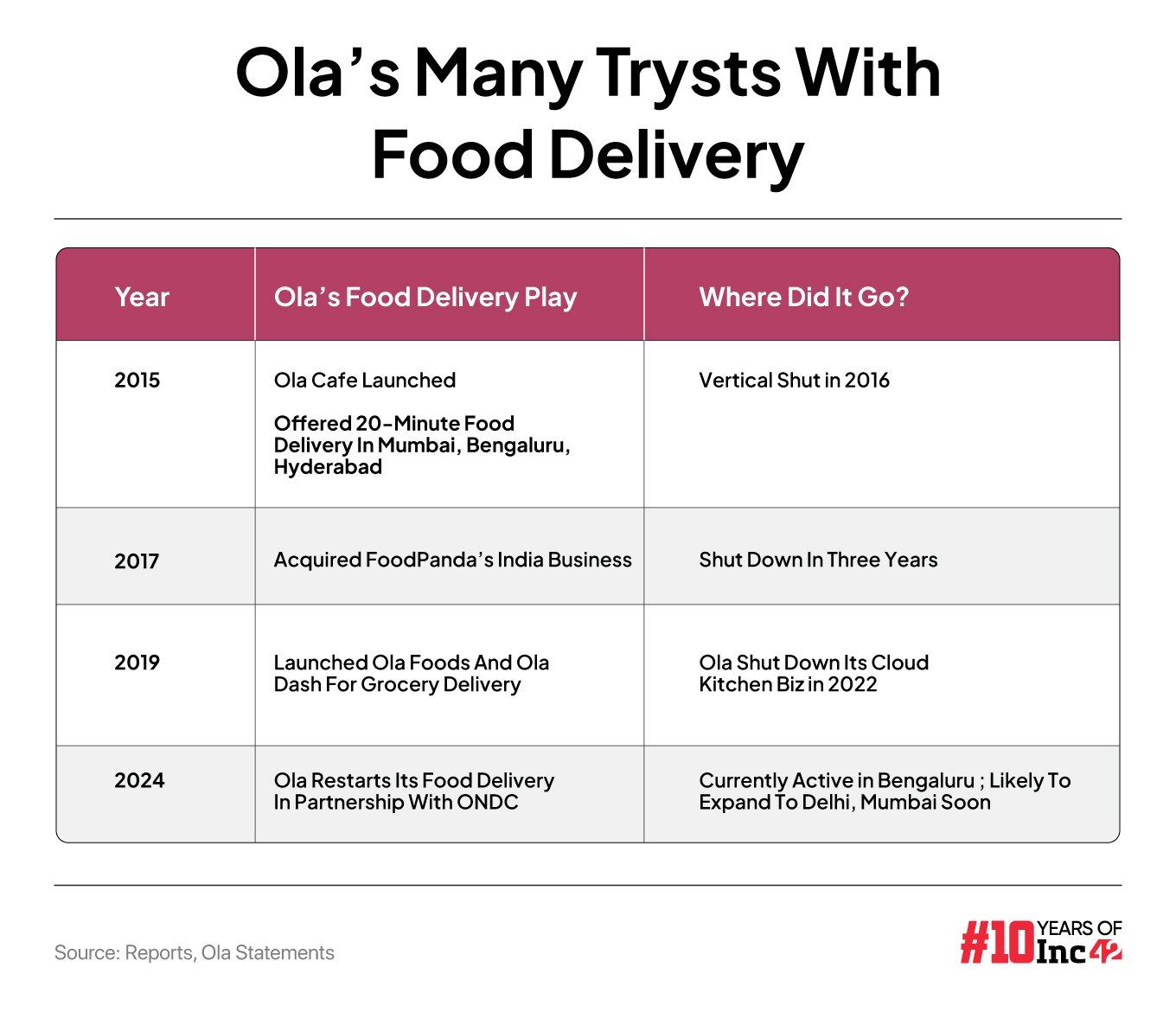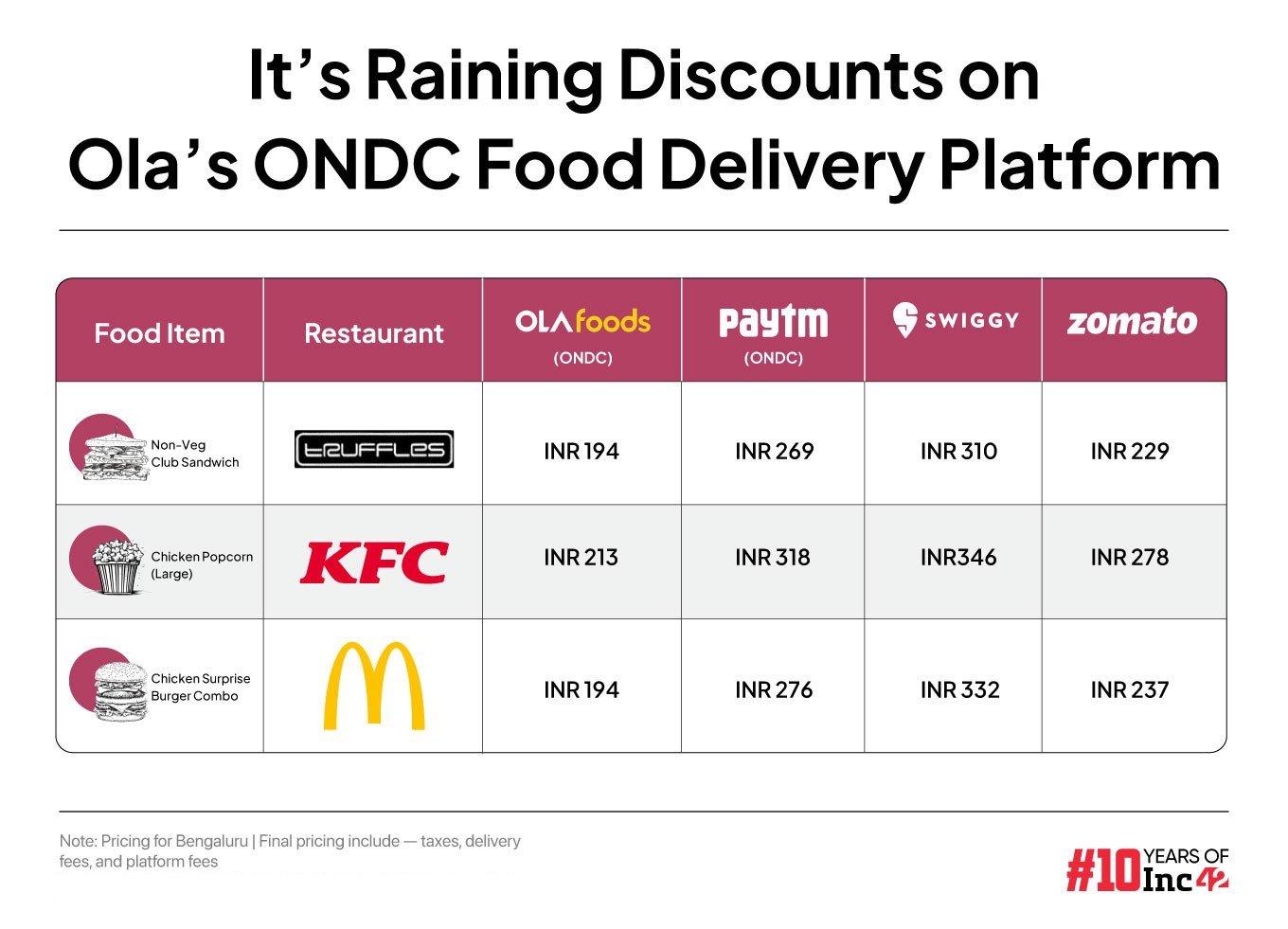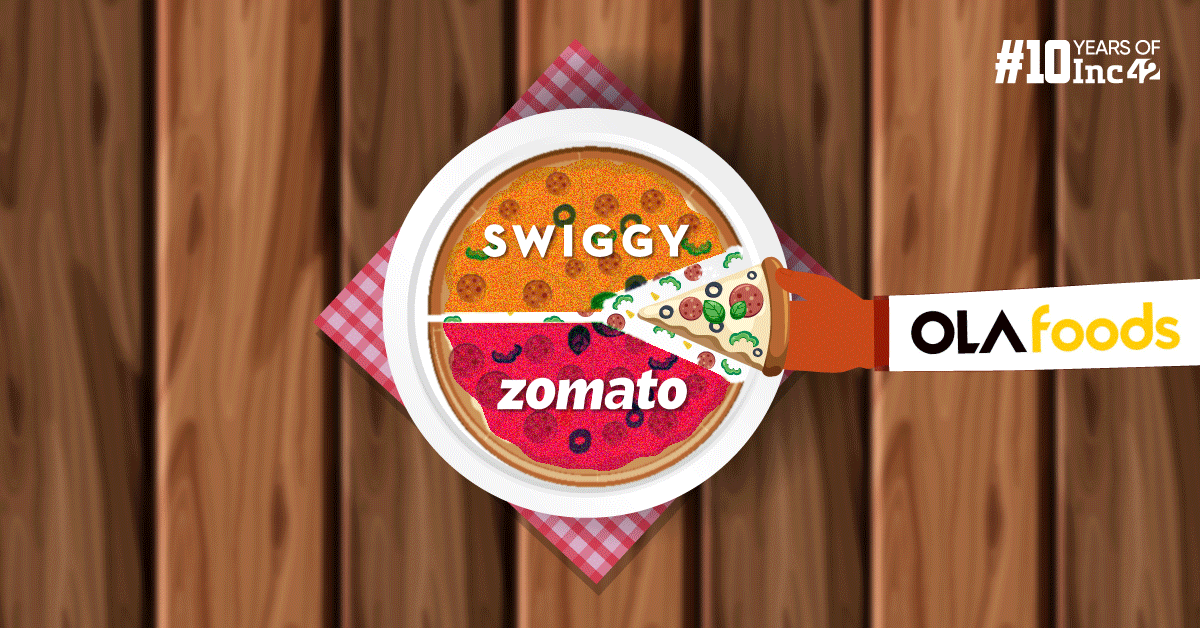Just a few weeks ago, social media was abuzz about Zomato and Swiggy, but most users didn’t have good things to say. The debate was about platform fees — rising from INR 1 per order in August last year to INR 6 in July 2024 — and how this has weakened the food delivery proposition.
But platform fees are only going to rise in the future. This is the price that consumers have to pay to get the convenience of food and quick commerce deliveries. And with no real competition in sight, Zomato and Swiggy pretty much follow each other’s moves when it comes to pricing.
We have seen the likes of Amazon, Uber Eats and Ola
But now, things might be changing. Large players such as Ola and Paytm are increasingly leaning on the Open Network For Digital Commerce (ONDC) to gain ground and disrupt Zomato and Swiggy with more attractive pricing.
To be clear, this is a battle that’s largely being fought on pricing thus far. ONDC-backed food delivery players such as Ola or Paytm do not have the operational expertise nor the resources to pull off food delivery on a consistent basis. In particular, Ola has leveraged ONDC to quickly mount a challenge, and take another shot at food delivery after its past failures.
In other words, ONDC has opened the doors to competition for Swiggy and Zomato. But can Ola and others banking on ONDC truly outpace Zomato and Swiggy?
Ola Dreams Food Delivery Again
Ola founder Bhavish Aggarwal has a fascination with food delivery. The company has attempted food delivery thrice through the Ola app, before the latest ONDC tryst.


When Ola and Aggarwal first experimented with food delivery through Ola Cafe in 2015, the idea was to build an instant delivery model through a restaurant network.
Unlike Zomato or Swiggy, which allowed consumers to browse through the entire menu of a restaurant, Ola limited itself to select few items from a handful of restaurants in the consumer’s vicinity. The company banked on its fleet for delivery, but the differentiated product did not go down well with consumers, and Ola Cafe was shut down within a year.
For act two, Ola acquired Berlin-based FoodPanda from Delivery Hero for $50 Mn in 2017, to again take on Swiggy, Zomato, as well as Uber Eats (eventually acquired by Zomato). The company wanted to replicate Uber Eats’ early success in India at the time, but once again, Ola fell short of the mark when it comes to user experience on Ola FoodPanda.
In 2022, Ola moved away from the restaurant aggregator model, and looked to leverage cloud kitchens to enter the space. Here, it was looking to emulate the likes of Rebel Foods, CureFoods, Box8, among others. Even though Ola put cofounder Pranav Jivrajka in place to lead this vertical, the business proved tough to scale up. Jivrajka quit the company just before the Ola’s third attempt failed.
But this time around, the company is hoping that ONDC will help it achieve its food delivery dreams, starting with Bengaluru. The company is also building a delivery fleet with EV bikes to improve the user experience, which was severely lacking in previous attempts.
According to ONDC seller apps such as Magicpin and uEngage, which bring restaurants on board, Ola has seen good user traction on account of efficient operations and in-house logistics.
“Food delivery orders work on crucial delivery timelines which is why if a company has been in the business for many years, it will have better efficiencies as it can manage sensitive peak hours, will have prior experience of tie-ups with restaurants,” owner of a Bengaluru-based cafe told Inc42.
In Ola’s case, a number of cloud kitchen brands and other infrastructure it was running until 2022 is likely to come in handy as it begins to scale operations to the other states. But it will not be easy to compete with juggernauts such as Swiggy and Zomato.
Swiggy is on the verge of an IPO to raise cash before expanding further, and Zomato is cash rich after its profitable stint in FY24. Given these developments, how far will Ola’s discounts-heavy play work?
Can Ola-ONDC Eat Into Zomato, Swiggy Share?
There is one advantage to Ola’s strategy of offering high discounts through ONDC. It expands the base of food delivery consumers who are wary of the higher prices and extraneous fees on Zomato and Swiggy. This means Ola can attract customers who were either on the food delivery fence or who have abandoned the two primary apps.
“Competitors like Zomato and Swiggy have entirely different business ambitions now compared to 2022. They aren’t looking to burn cash anymore which will definitely give more room to Ola to acquire more users through better user experience and discounts,” uEngage founder Sameer Sharma said.
Sources told Inc42 that Ola’s Aggarwal is feeling bullish about eating away at market share by offering heavy discounts. In fact, Ola has also reduced take-rates from restaurants by 50% in comparison to Zomato and Swiggy, which has at least worked out in Bengaluru.
“When Ola begins charging delivery fees, it will be still another revenue source for the company. I think Bhavish is fully prepared to do the heavy lifting for ONDC in the food delivery space this time,” the source quoted above said.


Ola’s discounts in food delivery as per Inc42’s analysis are staggering. Ola is offering 70-80% cheaper food delivery than Swiggy, Zomato and even other ONDC buyer apps like Paytm or Magicpin.
In fact, sources tell us that Ola is also providing free deliveries for every order, which has doubled its order volumes in the past couple of months.
Susmit Patodia, associate partner at early-stage venture capital firm Antler, believes that ONDC cannot dictate the pricing or discounts even though that was the case during the first two years. Now it’s left entirely up to the participants to decide the pricing for every order.
Bengaluru-headquartered Antler has built a thesis around investing in startups that are building on the ONDC protocol. “We need to reinforce the idea that ONDC is an open protocol where the network participants will play a huge role in the price determination, the waiver of delivery charges. This includes even the merchants or sellers who are now realising that ONDC is a viable option,” Patodia said.
He added that although ONDC has taken giant steps in the initial years, and that cash burn is not a big problem for the moment. “The ecommerce giants have grown and scaled up after burning cash for about 5-7 years, including Zomato and Swiggy. The total cash burn under the ONDC model is not comparable to that, at the moment,” Antler’s associate partner added.
In both cases the idea is the same: get consumers habituated to ordering online, and gradually taper down the discounts. The big question is can Ola even scale up to the extent where it can take its foot off the discounts pedal?
For that, it needs to build the leadership and the network effects that Zomato and Swiggy have. Both platforms offer a robust system for restaurants to manage online orders and also help in advertising and marketing, albeit this comes at a cost. How far can Ola replicate this on its ONDC-linked platform?
ONDC’S Food Delivery Menu
Ola, Paytm and others on ONDC’s food delivery bandwagon are also banking on the network adding familiar features to ease onboarding of consumers and merchants.
For instance, popular Bengaluru eateries are in the process of setting up QR codes that will enable consumers to place orders through ONDC-enabled apps on their smartphone.
In fact, ONDC launched the interoperable QR code system on Tuesday (July 30), which allows sellers to generate a unique QR code that consumers can scan using an ONDC-registered buyer app, starting with magicpin and Paytm.
This will soon be expanded across the entire network after initial testing.
Within food delivery, this could help increase visibility of ONDC buyer apps as they look to take on Swiggy and Zomato.
Neither of these two food delivery giants have such QR codes displayed inside restaurants. It must be understood, however, that the QR codes solve a problem that is unique to ONDC.
While QR codes will be added soon, ONDC’S food delivery order volume has almost tripled to 14 Lakhs per month in June 2024 from 5 Lakhs per month in March this year.
Currently, Zomato and Swiggy may together command close to 90% of the market in Delhi and Bengaluru, where ONDC has launched. But is the open network eating into this duopoly?
“Swiggy and Zomato are great companies. But this market is so huge that there is definitely room for other players which offer seamless user experience, cheaper alternatives especially if the hotels, restaurants are themselves willing to discount the end user without the aggregator,” uEngage founder Sharma added .
On the flip side, one does wonder, will ONDC see a decline in food delivery volumes when the discounts are taken off the table, especially if participants actually want to turn profitable.
Currently, Ola ONDC charges anywhere between 5% to 10% in commission on each order besides nominal delivery charges. But not everyone wants to splurge on discounts to chase the food delivery high.
PhonePe-backed Pincode and Paytm, which offered as much as INR 100 discount on each food order and free deliveries, are changing their tune.
Sources claim Pincode has found it hard to navigate through the fragmented ONDC landscape of partners such as third-party logistics players, customer support companies, payments partners and more.
Paytm took its foot off the discounts accelerator due to headwinds in its core UPI and merchant payments businesses. The fintech giant has turned the focus away from food delivery discounts, prices on Paytm are closer to Swiggy and Zomato prices than Ola.
Lessons From The Past
Of course, Ola’s potential success in the future will only serve to attract other players to the ONDC space. Amazon has long held ambitions to scale food delivery beyond Bengaluru, while Flipkart is also considering early moves for ONDC-based food delivery.
Flipkart and Amazon India were well positioned to foray into food delivery and leverage their existing user base, as well as logistics to make a dent. But there is pressure on both these giants to move towards profitability. This curtailed any food delivery ambitions held by Amazon and Flipkart never made a serious move into the space.
Can Ola’s ONDC success lure these players in?
“Amazon is also in a wait-and-watch mode to see the traction enjoyed by Ola and other such ONDC apps. It may enter the space if Ola can prove that ONDC works for food delivery,” the owner of a popular cloud kitchen brand told us on the condition of anonymity. .
Antler’s Patodia added that one cannot ignore the challenges that being faced by merchants and restaurants in getting on board ONDC buyer apps. He acknowledged that the platform needs to remove the hurdles in the way.
“Perhaps we will see founders and startups building products that will solve the impending issues associated with seller integrations and make them swifter and simpler. ONDC is too young right now but it is off to a good start. Scaling to 10 Mn transactions a month in two years is no easy feat,” Patodia added.
[Edited By Nikhil Subramaniam]

